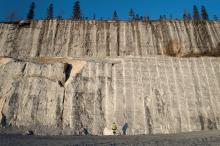
RSSOnerous red tape is one of the significant challenges to operating quarries in Malaysia. ABE takes a look at the difficulties faced by the Cheras granite quarry
All quarries face legal, environmental and health and safety hurdles in order to operate but the challenge faced by Malaysian quarries is particularly onerous. According to
The company's Cheras quarry near the Malaysian capital of Kuala Lumpa needs 21 different licences in order to operate. Hanson has an over riding licence to operate the quarry until 2025. "It's an ongoing thing but we don't have full tenure. There are a multitude of licences you have to apply for continuously. Some expire as frequently as quarterly. It's quite a challenge," Landry said.
The fact that the quarry is in the Klang Valley, only a dozen or so kilometres from the centre of Kuala Lumpur, and has housing development beyond it, is undoubtedly seen by bureaucrats as a reason for keeping tight control.
Landry said, "The Department of the Environment in particular, has strict regulations, we both monitor operations to make sure those are closely adhered to. Customers are as close as a couple of hundred metres from our crushing plant and housing development is heading
right past." Another impediment to efficient operations, are substantial government tariffs imposed on imported dump trucks, like those available from
Landry said that industry associations were raising the issue with the Malaysian government to try to get the tax reduced. "If it can free up the market that will be a step forward for the industry," he said.
Because they are relatively cheap, costing between €19,000 and €26,500 (RM70,000 to RM100,000), Hanson and other quarries throughout Malaysia, use what they call Larry Huntus, for hauling rock to the crushers. The trucks are what would be known in Australia as military surplus from the 1950s and 1960s.
Overall Hanson-Heidelberg Cement runs 17 aggregate quarries, 40 ready mixed concrete plants and 17 asphalt plants in Malaysia. It bought the 25ha Cheras plant, one of the major quarries to supply the Kuala Lumpur area, in 1996. At that time it commissioned
The plant was commissioned in 1996 on a turnkey basis with crushers supplied by Svedala, which has now been incorporated into Sandvik Mining and Construction. The system is still fully operational after 14 years of continuous service.
Equipment supplied includes a Jaw Master JM1513 primary crusher, a S4000EC secondary crusher and two H4000MCs tertiary units. Sandvik's Automated Setting Regulation - intelligent - (ASRi) crusher control systems were installed in 2008, to optimise crusher performance. Neither crushing nor material grading is done by remote control.
Processed material is granite with a work index of 21. Current plant output is 500tonnes per hour of 0-20mm and 150tonnes per hour of 0-125mm. Fractions produced include 150-230mm, 50-70mm, 50mm crusher run, 38mm, 5-10mm and 10-20mm aggregate, 0-5mm quarry dust and quarry waste. Most production goes into ready mixed concrete, road base and asphalt.
The Hanson group out sources drilling and blasting in all its quarries. At Cheras they are working currently at a maximum depth of 87m on a 12m deep bench.
The contractor is using an Ingersoll Rand C580 hydraulic drill to penetrate to between 10 and 11m using an 89mm diameter drill to produce holes spaced every 3.3 to 3.7m.
Landry said DTH drilling was not common in Malaysia, because it was not suitable for control blasting, which requires hole diameters of less than 89mm. He said it was usually used for high bench drilling to reduce hole deviation to less than 15mm.
The average non electric charge of bulk emulsion explosive per hole is 45kg for a control blast with decking and 55kg for a normal blast. For a control blast an average of 5tonne of crushable granite is produced while for a normal blast, about 15tonne is usual.
The company uses 40tonne excavators to load the Larry Huntus which haul the granite to the crushers on top of the quarry. Landry said they prefer excavators because of a lack of skilled wheel loader operators for face loading. When they have used wheel loaders, higher operating costs have resulted, particularly from increased tyre wear.
He said another reason they preferred excavators, was because the quarry pit was relatively small, and excavators could travel the short distances required quite quickly. Also, the inconsistency of the blast result made excavators more suitable for the face loading involved, Landry said.
Worldwide, once Hanson's quarries and sand pits reach the end of their lives, they are returned to a natural state or put to agricultural use. At Cheras, the rain forest has re-established on the worked out top benches of the quarry. Tropical rain forest soils are universally poor but rarely as nutritionally poor as pure granite. Nevertheless, the top three or four benches of the Cheras quarry, have after three or four decades, been fertile ground for quite good stands of various forest species which have softened the quarry's visual harshness.RSS









